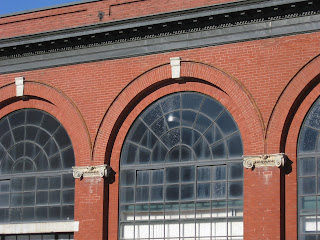I'm talking about hydro houses. I've been aware of them for years, but never paid much attention. The one I can readily recall in the east end is a nondescript little red brick bungalow. Will have to track down a photo someday soon.
 Hadn't given hydro houses any notice, with or without camera until a daytrip to Kingston last week. Striding along Brock street, on one of the sidewalks blessedly clear of ice and snow, I spied this nice Deco house. Front lawn with spruce, unidentified deciduous tree, tidy foundation plantings. Looked inviting, until a closer look revealed its identity.
Hadn't given hydro houses any notice, with or without camera until a daytrip to Kingston last week. Striding along Brock street, on one of the sidewalks blessedly clear of ice and snow, I spied this nice Deco house. Front lawn with spruce, unidentified deciduous tree, tidy foundation plantings. Looked inviting, until a closer look revealed its identity.Although the strictly business steel front door was surrounded by a finely moulded Deco frame, the DANGER High Voltage Keep Out put me instantly on the trail.
No notes to the milkman on this homely brick stoop. This is the home of Kingston Hydro Substation No. 2.

Hydro substations convert high voltage electricity from power generation stations to 220 and 240 volt service suitable for domestic use.
An online search revealed several sources with information about hydro houses. All focus on Toronto specimens (of which there are 250 and counting, downward, as they reach end of life and are demolished.) What intrigues me is the architectural diversity among them.
 |
| horizontal banding, dentils, tight eaves, flat roof |
 |
| homey shutters, sash windows |
 |
| hexagonal window, nicely framed |
Understandably, after the depression and the war, the team toned down their urban substations.That would explain the 'plain Jane' on Herchimer Street in the 50s and 60s neighbourhood near us. (I'll record it, and two others in Belleville, on Jones Street (that must be a playground structure to the right, if the principle of camouflage is still at play) and a utilitarian modern structure on Reid Street. My guess is that these neighbourhoods weren't so fussy, or Hydro had just stopped caring.
Here's a link to a Heritage study which provides more than you might ever want to know about a typical residential substation in Windsor. One thing it does, that most of us don't, is to honour this powerful bit of our built heritage.
Here's Blog TO's photo essay, and a 2012 article in The Walrus, if you want to see more. I will certainly be on the lookout in a town near you. Do let me know if you have a Hydro house in your neighbourhood!
This lovely classical building still fits in well with the historic downtown (if you overlook the expanses of parking lot signalling overzealous demolition.) It was built in 1892 as the HQ for the privately owned Kingston Electric Light Company. Today it's a distribution substation for Kingston Hydro.



No comments:
Post a Comment